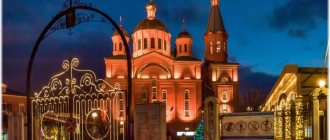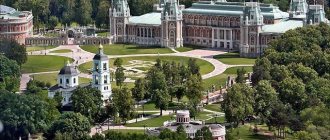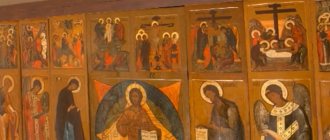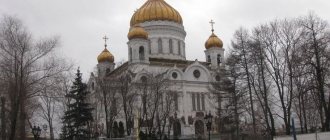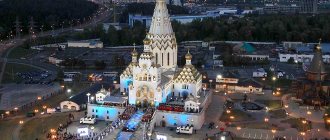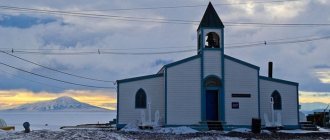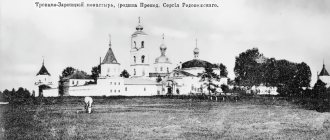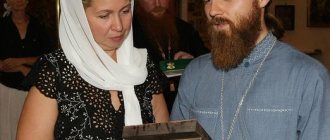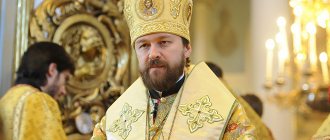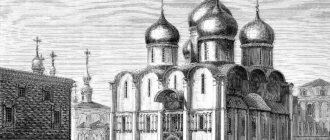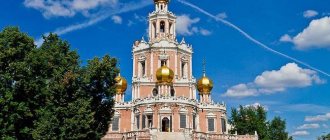Rozhdestvenskaya street
The street connecting the square in front of the Annunciation Monastery
with National Unity Square near
the Nizhny Novgorod Kremlin
, is unique in its own way. It is a real open-air museum. Here you can see houses built in the mid-18th century and the picturesque Church of the Cathedral of the Blessed Virgin Mary. In total, in this part of the city there are 35 cultural heritage sites - state-protected architectural monuments.
View of the church from Suetinskaya street
The place where the street is now laid was inhabited for a very long time, from the very foundation of the city. The famous engineer and designer Augustine Bettencourt (beginning of the 19th century) ordered that, in order to avoid fires, the street should be built up with stone buildings and, by demolishing dilapidated houses, straightened. Years passed and this street turned into the business center of Nizhny Novgorod.
Current state[edit]
At the beginning of the new century, a European-quality renovation was carried out on the monument.
On July 24, 2008, Chairman of the Government of the Russian Federation Vladimir Putin handed over the icon of the Resurrection of Christ to the Nizhny Novgorod diocese. The icon was stolen from the Church of the Cathedral of the Blessed Virgin Mary on October 22, 2004, among 18 icons. In 2007, the icon was bought by a collector in Estonia and brought to Russia. Having discovered it in the catalog of stolen things, he decided to return it to the Russian Orthodox Church.
History of the Assumption Church
The construction of the temple has a rather long history and is connected with the fate of the Russian entrepreneur, merchant and politician, representative of the eminent noble family of the Stroganovs - Grigory Dmitrievich. Grigory was the only son of Dmitry Andreevich Stroganov. He inherited rich estates from his father - several towns, villages and hamlets, as well as more than 1.5 thousand serfs.
General view of the church
Natural intelligence and entrepreneurial flair allowed Grigory Stroganov to significantly increase the family wealth, and he became the owner of more than 200 villages, where 15 thousand serfs lived. In Nizhny Novgorod, Stroganov had great commercial interests, since salt could be traded profitably here. In 1696, with the money of a salt industrialist, the city began construction of a stone temple.
In five years, this church was almost built, but there was a big fire, and the new, not yet opened church was badly damaged.
In 1703, a state monopoly on the production and trade of salt was introduced in Russia, and therefore Nizhny Novgorod ceased to interest Stroganov, and he did not even appear in the city. As researchers suggest, Stroganov simply stopped financing the construction of the temple, and construction was suspended for many years.
In 1715, at the age of 59, Stroganov died, and his widow Maria Yakovlevna undertook to complete the construction of the church. Thanks to her labors and allocated funds, the interior of the temple was completed and the throne was consecrated in 1719. The church became a house church in the city estate of the Stroganovs.
Only two years passed, and Tsar Peter I closed the Stroganov Church by personal decree.
Therefore, services were not held here until the death of the sovereign in 1725.
General view of the church and bell tower with the Kanavinsky Bridge in the background
It is also known from the history of the church that it suffered several times during fires. Particularly severe destruction occurred in the 60-80s of the 18th century. However, at the beginning of the 19th century, at the expense of the grandson of Grigory Stroganov, Alexander Sergeevich Stroganov, the temple was thoroughly restored.
The next reconstruction of the temple took place in the 1820s, and they were led by Augustine Betancourt and academician of architecture Ivan Efimovich Efimov. They understood how important it was to preserve the beautiful Stroganov church, and decided to strengthen it with a special additional wall, and connect the bell tower building, which previously stood separately, with the porch using a new covered passage. Interestingly, during this reconstruction, bricks were used that were left over from the dismantled old Church of the Nativity, which gave the name to the street.
In 1860, due to ground subsidence, the temple bell tower began to tilt noticeably. Over the next two decades, it deviated from the vertical position by 1.2 m.
The situation was so critical that the building could collapse at any moment. Therefore, it was necessary to urgently replace the foundation and upper tiers of the bell tower (1887). These works were supervised by famous Nizhny Novgorod architects Lev Vladimirovich Dal and Robert Yakovlevich Kilevein. And the last major restoration before the revolution took place in the temple in 1913.
View of the church from Rozhdestvenskaya street
After the advent of Soviet power, the fate of the church changed. At first they just wanted to destroy it. Father Sergius (Veisov), who was the rector of the temple since 1915, made a lot of efforts to have the ancient church recognized as an architectural monument. He collected documents and old photographs, gave lectures on the significance of the Stroganov Baroque and achieved his goal. The temple was not touched, but during the active anti-religious struggle, church services were banned here (1934). The city atheist museum is located inside the building. And the former rector of the temple, Weisov, was appointed its first director, and Hieromonk Spiridon as its guard.
Restoration work in the temple began after it was returned to believers (1992). A year later, the church was re-consecrated.
On the verge of death
Everything of value in the eyes of the Bolsheviks was confiscated in the first years of Soviet power, but the Stroganov Church itself remained active until 1934, after which it was closed and designated for demolition as “a hotbed of religious obscurantism.” No arguments based on the artistic and historical value of the building had any effect on the “owners of the new life,” and the unique architectural monument was practically doomed.
He owes his salvation to his rector, the Nizhny Novgorod priest Father Sergius (Weisov). Having collected a large number of archival documents and photographs, he gave dozens of lectures in the offices of senior party functionaries and finally achieved what he wanted.
Clock on the bell tower
A very interesting story is connected with the “astronomical” clock that once adorned the temple. In 1750 they broke down. And the only one who managed to fix the watch was 15-year-old teenager Ivan Kulibin
- later a famous Russian master, nicknamed “Archimedes of Nizhny Novgorod”. Unfortunately, antique watches with a unique mechanism have not survived to this day.
Then an ordinary clock was installed on the belfry, which chimed every hour, but by the beginning of the 20th century it broke down. On the stone slabs around the clock, ancient Slavic letters are still visible, with which the circle is divided not into 12, but into 17 parts, as was customary in Ancient Rus'.
View of the southern façade of the church
In 2005, another tower clock with an equally interesting history was installed on the two-tier bell tower, topped with a cross and a weather vane.
In 1879, this unusual watch mechanism was manufactured by German craftsmen at the factory of Johann Friedrich Woile. At first, the clock was placed on the building of the Blinovsky Passage, which also stands on Rozhdestvenskaya Street, not so far from the Stroganov Church. In 1917, the clock mechanism was removed from there, and until recently it was kept in the city historical museum.
In the 1990s, they tried to mount an ancient clock on the church belfry, but they did it ineptly, and the clock mechanism never worked. In 2004, Kaluga master Alexander Georgievich Krasnikov took on the restoration of the clock. He was able to completely restore the original mechanism, and only four hour dials required replacement. Today, an 80-kilogram bell, placed at the top of the bell tower, strikes the right time every hour, and every half hour a single blow is heard above the temple. Interestingly, the vintage watches are completely mechanical and require manual winding once every two weeks.
Church bell tower
Architectural monuments
Rozhdestvenskaya street. View from above
Christmas street in the evening
- Night house of N. A. Bugrova (Rozhdestvenskaya st., no. 2)
- Public house (Rozhdestvenskaya st., 6)
- The apartment building of N. A. Bugrova, where the Volzhsko-Kama Bank was located (Rozhdestvenskaya St., 27)
- Residential building of the Stroganovs (Suetinskaya st., 23)
- Stroganov Estate (Rozhdestvenskaya St., 45a, 45b, 45c)
- Estate of the Princes Golitsyn (Rozhdestvenskaya st., no. 47a, no. 47v, no. 47c)
- Hotel Smirnova (Rozhdestvenskaya st., 28)
- Blinovsky Passage (Rozhdestvenskaya St., 24)
- Rukavishnikov Bank complex (Rozhdestvenskaya St., 23, Nizhnevolzhskaya embankment, 9)
Temples
There were six temples here. Starting from the Kremlin:
- Church of the Nativity of John the Baptist (an architectural ensemble consisting of a temple and two chapels: “Spasskaya” (at the altar of the church) and “Tsarskaya” (to the left of the church porch)). Preserved. Restored.
- Church of St. Nicholas the World of Lycian Wonderworker “on the Market” (now in its place is the business center “Ant”). Destroyed.
- Church of the Life-Giving Trinity (Vakhitov lane). Destroyed.
- 2 churches of St. unmercenaries Kozma and Damian: old and new (modern Markin Square). Both are destroyed.
- Church in the name of the Cathedral of the Blessed Virgin Mary (Stroganovskaya, Rozhdestvenskaya). Preserved.
View of the eastern part of Rozhdestvenskaya Street from the Kremlin Hill (Chasovaya Hill)
The architecture of the temple and its interior decoration
The Church of the Nativity is one of four monuments of the Stroganov Baroque that have survived in Russia.
Externally, this church resembles a precious carved box. Its facades are covered with magnificent stone carvings, on which you can see images of intricate shells and curls, grape vines, flowers and beautiful fruits.
The temple is two-tiered and has a three-apse altar and a pillarless refectory. On top it is crowned with five chapters, placed at the cardinal points. Initially, their domes were green, but since the end of the 19th century, the domes have been painted in different colors, like the Intercession Cathedral
on Red Square
in Moscow
.
Architectural ensemble
The existing Orthodox Nativity Church was built on a half-mountain and stands out very much with its contrast of white and red colors against the background of the river slope. The structure externally resembles a carved palace with richly decorated windows, white stone entrances, and columns covering the building as if with a blanket. The heads of the church are crowned with crosses forged with openwork reliefs, representing the best examples of blacksmith masters. Initially, the color of the five domes was green, and then - at the end of the 19th century - they were repainted like St. Basil's Cathedral in Moscow.
Next to the Stroganov Church there is a bell tower - it was built a little higher than the temple itself. On the top of her head stands a patterned weather vane, representing a flag fluttering in the wind. Once upon a time there was a working clock on the wall of the bell tower, but today only the dials themselves have been preserved, and their old mechanism has been lost. It is only known that his work was observed and repaired if necessary by the Russian master mechanic I.P. Kulibin. Due to improper laying of tiers in the 60s. In the 19th century, the bell tower began to gradually fall. Over a twenty-year period of time, its axis deviated from the vertical by 1.2 meters. It was decided to shift the upper tiers and change the foundation of the bell tower. At the lower level of the bell tower there is the main entrance through which you can enter the church. Despite the wealth of carved decorations on the walls of the temple, the interior decoration of the church is somewhat modest. Only the iconostasis can amaze you with its beauty, elegant carvings and impressive painting. The manner of painting icons of the 18th century is observed in the church.
Korniliy Ulanov and his student Gorodchaninov painted the icons “The Adoration of the Magi” and “The Cathedral of Our Lady”, while the images located in and “Our Lady” are the creations of the court artist of the merchants Stepan Narykov. An interesting fact is that it was the icon “Savior Pantocrator” that was painted in such a way that the face of the saint depicted on it bore a portrait resemblance to the founder of the church G.D. Stroganov. The legend tells about the rage of Peter, who once visited the Nativity Church. Having shouted a phrase about his reluctance to worship his subordinate Grigory Stroganov, he ran out of the temple. Perhaps this was the reason for its closure for three years - until the death of the sovereign.
Nowadays, the church houses a very old icon of St. Nicholas the Wonderworker, images with particles of the relics of famous saints, as well as the revered Sovereign Icon of the Mother of God. The Nativity Church is an architectural monument at the federal level; it is often visited by both Orthodox guests of the city and ordinary tourists visiting the sights of Nizhny Novgorod.
Current state of the temple and visiting hours
The Orthodox Church is active, and its doors are open to everyone - believers and tourists on any day. Services in the church are held daily. The patronal feast day is celebrated here on January 8th.
Particularly revered temple shrines are the ancient icon of St. Nicholas, a copy of the “Sovereign” icon of Our Lady, as well as several icons with pieces of the relics of Christian saints.
Domes of the Nativity Church
Interior of the Stroganov Church in Nizhny Novgorod
The interior of the Stroganov Church, as can be seen from its external outlines, consists of a rather low refectory and a prayer hall located in the main quadrangle. Its interior preserves what was irretrievably lost in other churches. Nevertheless, before the Nativity Church was incomparably richer.
Thus, in the spacious refectory hall, only the eastern wall, separating the refectory hall from the main one, now reminds of its former splendor. It is all covered with stone carvings. Originally executed in white, it was later heavily covered with gilding, thereby making it look like an iconostasis. In addition, previously all the walls of the refectory were painted with biblical scenes. In Soviet times, they were bashfully hidden by whitewash.
The prayer hall is small in size, but high and bright, making it seem larger than it actually is.
The visitor's attention is immediately drawn to the carved gilded iconostasis. The carvers used a grapevine motif, traditional for Christian art, in its design.
The material chosen was also traditional - linden, pliable to the master's chisel. The details of the iconostasis were assembled using a tongue-and-groove system, without nails, and after assembly, the marvelous altar barrier was covered with gesso and gold leaf.
The iconostasis consists of four tiers - local, festive, deisis and prophetic. It is crowned with the Crucifixion. Almost all the icons in the iconostasis are original, preserved from the beginning. The Royal Doors, which, unlike other parts of the iconostasis, are made of oak, are particularly striking in their richness of carvings. It seems as if they all consist of complex interweavings of branches and leaves surrounding medallion icons of the evangelists, the Mother of God and the Archangel Gabriel.
The height of the church hall made it possible to place choirs in its second tier, thanks to which the singing during the service was heard from above. This is probably what G.D. intended. Stroganov, who was extremely fond of good church singing and maintained an excellent choir (Stroganov’s singers were even demanded to the court more than once).
On the verge of destruction
The persecution of the church that followed after the Bolsheviks came to power also swept Nizhny Novgorod. The Nativity Church, whose history during these years was similar to the fate of many Orthodox churches in Russia, was closed and, in accordance with the order of the authorities, was subject to demolition.
Only the selfless actions of its abbot, Father Sergius (Veisov), helped prevent a disaster. He literally gave lectures to officials, talking about the artistic merits of the church, which is a unique example of the temple construction of the Stroganov Baroque.
His labors were crowned with success, and the church was saved. They didn’t even try to convert it into a warehouse or a machine and tractor workshop, as was often done in those years. A museum of religion and atheism was created there. Perhaps the Bolsheviks thought it was very ingenious to place anti-religious exhibitions in the Church of God, or perhaps they took an example from their St. Petersburg colleagues, who created a similar museum in the premises of the city’s main cathedral, the Kazan Cathedral.
How to get to the Church of the Cathedral of the Nativity of the Blessed Virgin Mary on your own:
Nizhny Novgorod lies at the intersection of many Russian roads - both railways and roads. From Moscow it can be reached by car along the M-7 highway (via Vladimir).
Trains passing through Nizhny Novgorod “start” daily from Yaroslavsky, Kursky and Kazansky stations. You will have to spend 6-7 hours on the way. The Sapsan high-speed train also runs between Moscow and Nizhny. It departs from Kursky Station daily and gets to Nizhny Novgorod in 4 hours.
In Novgorod itself it is easy to find the Stroganov Church. For example, if you arrived by train and want to see this unique temple without missing a minute, take the 5th tram near the station and go to the “Rechnoy Vokzal” stop. The church is located right next to this stop.
Common features in the fate of the temples
By order of the new Soviet authorities, both churches were closed at the end of the 20s.
The further fate of both churches was not happy - it was decided to exploit their premises for the benefit of the socialism under construction.
They tried to turn the Vladimir Church, deprived of the upper dome part, into a school, then into a club institution. But, in the end, they equipped it with a bakery
, where for almost half a century bakery products were baked for the residents of Kanavino.
The Smolensk church was more fortunate - it became a warehouse for cultural workers.
In the early 90s
The Smolensk Church was returned to the believers, who, at the invitation of the diocese, washed it themselves, cleared it of debris and dirt, and themselves collected the icons available at home with the whole world. Services began in the consecrated church.
The unified architectural ensemble of the Smolensk-Vladimir parish,
the Vladimir Church, was returned to believers only by the end of the 90s
. Its condition was terrible - the walls were covered with soot, broken glass and mountains of construction waste, rats and mice scurrying through the garbage heaps. But the strength of spirit and the desire to restore the temple overcame the consequences of the destruction - just two years later, the not fully restored Vladimir Church held its first Easter services.
For other temples in Nizhny Novgorod, see Temples of Nizhny Novgorod
Author of the article: Kasatkina Tatyana
